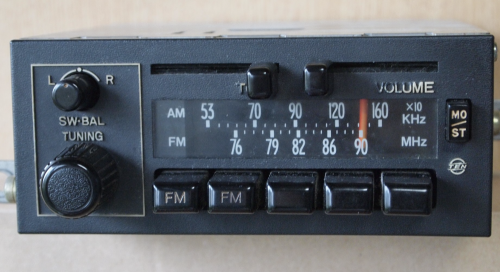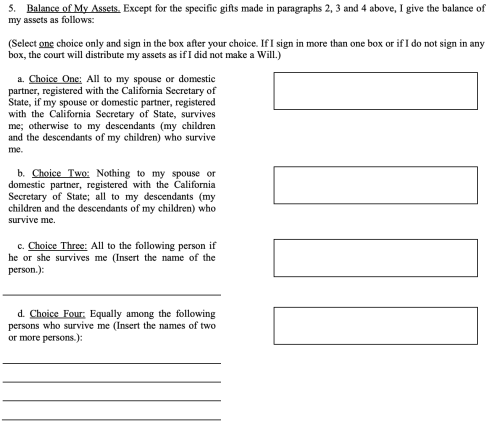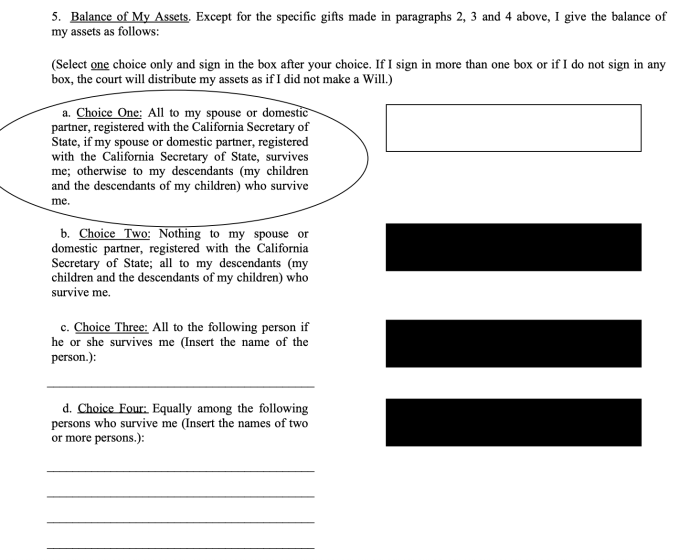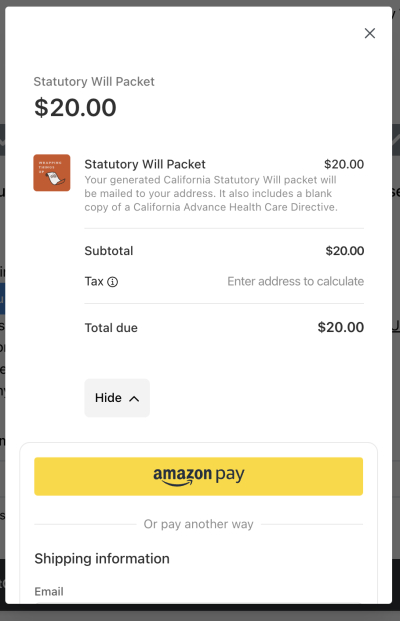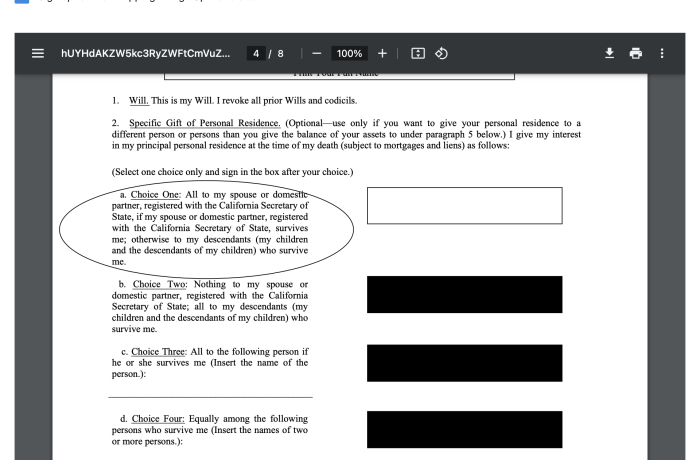What Does the California Statutory Will and Radio Buttons Have In Common?

The Beginning
The California legislature did something big for access to justice in the early 1980s, but most residents are unaware. Over 40 years ago, the legislature passed into law the California Statutory Will (Probate Code Sections 6200-6243), giving residents the ability to create their own wills simply, and for free. Only four other states have done the same, and the motivation behind this is to allow people to create their own valid wills without the need for an attorney.
The statutory will is a template that will validly function as a will if certain conditions are met. Probate Code Sections (6220-6227).
Despite being simple with few options for customization, many (not all, and for a proper analysis, please seek legal advice from a California licensed attorney) people’s scenarios along with their wishes can be accomplished by using this form if:
there are no estate tax issues,
there is no desire to avoid probate. The California Statutory Will as with any other testamentary will, alone does not avoid the California probate process, and
there is no need to maintain control of assets after one's death. (Children with gambling issues, bad spending habits).
When the statutory will was first introduced, personal computers were not ubiquitous, nor was the internet and home printers. For someone to get their hands on a statutory will form, they would have had to go to a stationary store to buy it. Even today, the California legislature does not print the statutory will or many other forms like it in full, directing the reader to "...see published chaptered bill for the complete section text".
What Does It Look Like
The will has a total of nine paragraphs, and a final section for signatures. Each paragraph prominently contains boxes for a person to fill. Of all the available statutory wills in the country (five: California, New Mexico, Michigan, Wisconsin, and Maine), California's is the most "blank-box" heavy. You can see for yourself - a blank copy of the actual PDF can be downloaded here.
How are you supposed to fill in those boxes? With the exception of the first box (where you print your name), and boxes 6-8 (where you print the names of people), the majority of the boxes are signature boxes to represent your selection. In fact, the legislature may not have realized it at the time, but the signature boxes are supposed to operate like radio buttons.
The idea of radio buttons (the bottom row of buttons in the above picture) is that through normal operation, only one choice can be made. If you press another button, the previously selected button pops up and is unselected.
Modern radio buttons now exists only on the web as a part of a user interface. Increasingly, more people are familiar with the web version as opposed to the actual radio one.
How does the radio button feature work on the statutory will? To illustrate it in action, see paragraph 5 of the statutory will below. The purpose of this paragraph is to allow the testator (the person making the will) to decide how to give away the rest of their assets after giving away other things like a house or a cash gifts. This is supposed to represent the balance or remainder of their estate. Sometimes, you may hear this described as the "residue of the estate".
Unlike the paragraphs above, this one is not optional, and a choice must be selected by signing a single box. If they wish to provide the balance to their surviving spouse, they sign the box associated with choice one. Perhaps you are starting to spot a potential issue.
Executing It Correctly
Even though the language of the California Statutory Will is light on legalese, and is supposed to be more accessible, this has not ensured that everyone reads the instructions and understands what they are signing.
The California Statutory Will is not a common will in probate. Lawyers are more likely to encounter holographic wills (strictly speaking, it's anything that doesn't meet the formal definition of a California will under Probate Code Section 6110, but these are known as written notes by the testator intending to be their last will), and DIY wills from websites like LegalZoom. When a lawyer comes across a statutory will organically, common errors are that no boxes are signed, or more than one box selection is signed. When this happens, the court will distribute the person's assets as if no will was ever made.
The understanding is that the tradeoff for using a fast and simple will to dispose of one's property is that there is very little room for faulty execution. As such, a testator should do everything in their power to ensure that when using a California Statutory Will there are no mistakes. To date, there is little case law concerning the California Statutory Will, but two appellate courts appear to interpret the law to allow some leniency when it comes to its execution (Estate of Perry, Estate of Smith).
The Guardrails
As a way to help resolve the issues laid out above, Wrapping Things Up provides a California Statutory Will generator that takes user inputs and transposes them onto the form while adding some guardrails to make it clear to the signer the signature box needs to be signed to effectuate their intent.
The Statutory Will Generator uses the concept of the radio buttons and makes an effort to ensure that the testator signs the correct box by blocking out ones that are not used. In doing this, it makes signing an incorrect box much more difficult.
Video Instructions
People are often overwhelmed when reading big blocks of text on their phone screens.
To make the use of a statutory will more palatable, we created short videos explaining the questions and potential answers, educating them on the different disposition outcomes.
There are also Spanish subtitles (close to a third of Californians speak Spanish), in addition to English.
A Printer As Access To Justice
Law moves slowly despite advancement of tech and digital documents. Wills and many other legal documents dealing with property rights still need to be hand signed, witnessed, and notarized.
"Dunder Mifflin, limitless paper, in a paperless world."
There is a scene in the show "The Office" when the character Michael Scott, the boss, directed an ad for local television. It ends with the paradoxical above quote. Much of today's legal field has transitioned away from actual paper. In fact, judges and opposing parties in litigation are usually dealing in PDFs, and many signatures can now be made electronically. Formal documents such as wills and transfer of property interest related to estate planning still require an original hand-signed paper document. This nonetheless and, ironically, results in being scanned and digitally displayed from databases on a computer screen.
If someone wanted to complete their own statutory will, without having a working printer, this would be an access to justice issue. Some relatively recent statistics suggests 70% of American households regularly use a printer in their homes. If true, the remaining Americans either don't own a printer or don't have a functioning one.
A solution we offer is to send a pre-filled form created by the user via mail. Orders are fulfilled and delivered within a week of purchase.
Users with printers can simply print their generated will for free upon the completion of the multi-step questionnaire. Using this method, user input information stays on the client browser, and is not sent to a server for processing or printing.
We are excited about the prospect of providing simple estate planning to millions of Californians, and we invite you to create your own simple and free will using the California Statutory Will Generator today.



